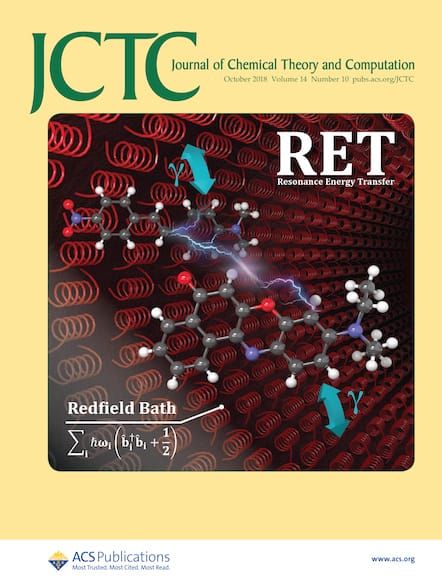基于粒子的短程振荡溶剂化力隐式溶剂模型。
IF 5.5
1区 化学
Q2 CHEMISTRY, PHYSICAL
引用次数: 0
摘要
实验和理论研究表明,当两个平行表面在纳米分离中接近时,溶剂分子在受限区域的有序分层会产生明显的短程周期性振荡力。然而,显式溶剂模拟的高计算费用阻碍了这些振荡力如何调节胶体组装动力学的详细探索。我们开发了一个隐式溶剂模型,用于在非极性溶剂中接枝非极性配体的表面,该模型以分子水平的保真度和计算效率解决了与角度相关的振荡溶剂化力,使用平均力分布的显式溶剂势进行参数化。含有数百个纳米粒子的胶体系统的微秒尺度隐式溶剂模拟进一步揭示了组装途径和相行为严重依赖于粒子的形状和大小。这种高效的建模框架为阐明溶剂介导的自组装机制和胶体结构的精确控制提供了强大的理论和数值工具。本文章由计算机程序翻译,如有差异,请以英文原文为准。
A Particle-Based Implicit Solvent Model for Short-Range Oscillatory Solvation Forces.
Experimental and theoretical studies have demonstrated that when two parallel surfaces approach within nanometer separations, ordered layering of solvent molecules in the confined region gives rise to pronounced short-range, periodic oscillatory forces. However, the high computational expense of explicit solvent simulations has hindered detailed exploration of how these oscillatory forces regulate colloidal assembly dynamics. We develop an implicit solvent model for surfaces grafted with nonpolar ligands in nonpolar solvents, which resolves angle-dependent oscillatory solvation forces with molecular-level fidelity and computational efficiency, parametrized using explicit-solvent potential of mean force profiles. Microsecond-scale implicit solvent simulations of colloidal systems containing hundreds of nanoparticles further uncover that assembly pathways and phase behavior critically depend on particle shape and size. This efficient modeling framework offers a robust theoretical and numerical tool for elucidating solvent-mediated self-assembly mechanisms and for precision control of colloidal architectures.
求助全文
通过发布文献求助,成功后即可免费获取论文全文。
去求助
来源期刊

Journal of Chemical Theory and Computation
化学-物理:原子、分子和化学物理
CiteScore
9.90
自引率
16.40%
发文量
568
审稿时长
1 months
期刊介绍:
The Journal of Chemical Theory and Computation invites new and original contributions with the understanding that, if accepted, they will not be published elsewhere. Papers reporting new theories, methodology, and/or important applications in quantum electronic structure, molecular dynamics, and statistical mechanics are appropriate for submission to this Journal. Specific topics include advances in or applications of ab initio quantum mechanics, density functional theory, design and properties of new materials, surface science, Monte Carlo simulations, solvation models, QM/MM calculations, biomolecular structure prediction, and molecular dynamics in the broadest sense including gas-phase dynamics, ab initio dynamics, biomolecular dynamics, and protein folding. The Journal does not consider papers that are straightforward applications of known methods including DFT and molecular dynamics. The Journal favors submissions that include advances in theory or methodology with applications to compelling problems.
 求助内容:
求助内容: 应助结果提醒方式:
应助结果提醒方式:


